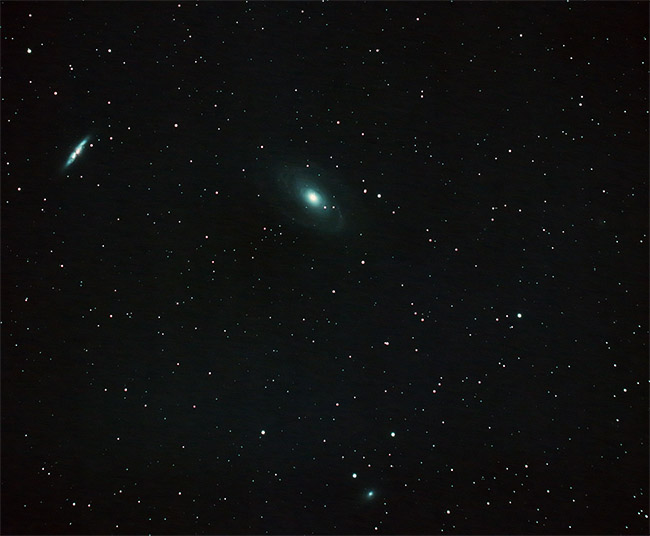M81 & M82
 It was full moon this night (99.6% full moon actually) so our expectations were pretty low on the night. My aim for this night was to try out my new skywatcher NEQ6 Pro mount. Whilst the subexposures were way too bright to bring out any good details of the galaxies, the mount worked PERFECTLY! The go-to was next to perfect (using a 3-star alignment) and the autoguiding just worked without any hassle (only had to change the calibration step from 750ms to 2000ms). I only did the polar alignment with the polar scope, no drift alignment! The mount guided well over one hour without any problems, I had to switch targets so it could probably continue on forever. I don't take this for granted as we've always had one problems or two when autoguiding before. I spent a great deal of time capturing the area around Jupiter in the hope of bagging some of the smaller moons (for instance Elara) but the full moon just made this impossible. For the next time this will be my goal!
It was full moon this night (99.6% full moon actually) so our expectations were pretty low on the night. My aim for this night was to try out my new skywatcher NEQ6 Pro mount. Whilst the subexposures were way too bright to bring out any good details of the galaxies, the mount worked PERFECTLY! The go-to was next to perfect (using a 3-star alignment) and the autoguiding just worked without any hassle (only had to change the calibration step from 750ms to 2000ms). I only did the polar alignment with the polar scope, no drift alignment! The mount guided well over one hour without any problems, I had to switch targets so it could probably continue on forever. I don't take this for granted as we've always had one problems or two when autoguiding before. I spent a great deal of time capturing the area around Jupiter in the hope of bagging some of the smaller moons (for instance Elara) but the full moon just made this impossible. For the next time this will be my goal! 
 A galaxy is a massive, gravitationally bound system consisting of stars, stellar remnants, an interstellar medium of gas and dust, and dark matter. Examples of galaxies range from dwarfs with as few as ten million stars to giants with one hundred trillion stars, each orbiting their galaxy's own center of mass.
A galaxy is a massive, gravitationally bound system consisting of stars, stellar remnants, an interstellar medium of gas and dust, and dark matter. Examples of galaxies range from dwarfs with as few as ten million stars to giants with one hundred trillion stars, each orbiting their galaxy's own center of mass. ― source and more information wikipedia
― source and more information wikipedia
Date: 2013-12-17
Location: Ekerö, Sweden
Temperature: 3 °C
Telescope: William-Optics Megrez 88FD
Camera: Canon 600D
ISO: 1600
Mount: Skywatcher NEQ6 Pro Synscan
Exposure time: 94 X 30 sec
Reducer/flattener: William-Optics 0.8X reducer/flattener (P-FLAT-F6)
Filter: Astronomik CLS
Other info: Autoguided with 50mm guidescope, QHY5-II camera and PHD software
Processing: Processed in Photoshop CS6. Stacked and dark-subtracted in DeepSkyStacker




 2013-12-17
2013-12-17 